Plums: Origins - Consumption - Nutrition Facts - Health Benefits
|
|
|
Contents
- Geographic origin and regions grown
- Common plum consumption today
- History of consumption
- Nutrition Facts: Vitamins, minerals and phytochemical components
- Health Benefits: Medicinal uses based on scientific studies
- Bibliography
When I was a child our family used to visit a great aunt in the middle of summer when we were on holiday. Aunty Kath had a large plum tree in her backyard and one of the things she made with the fruit was jam. Home made jam on pikelets and scones was a favorite afternoon tea :).
Geographic Origins and Regions Grown
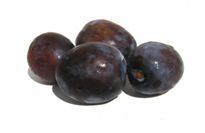 |
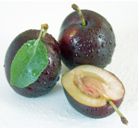 |
It is also known as a gage and is a stone fruit that belongs to the genus Prunus and subgenus Prunus. The subgenus is separated from other fruits like bird cherries, cherries, and peaches because the shoots have a terminal bud and solitary, side buds instead of clustered buds. The flowers are in groups of 1 to 5, have short stems, and they have grooves that run down one side and one smooth seed.
When the tree blossoms in the early spring, it is covered with flowers and in a good year approximately 50% of the flowers will be pollinated and become fruit. Flowering starts in the spring 80 days after the stem starts to grow. If the weather is too dry the fruits will not develop past a certain stage.
Instead they will fall from the tree while they are still tiny green buds. If the weather is unseasonably wet or if the fruit are not harvested as soon as they are ripe, they may develop a fungal condition called brown rot. Brown rot is not toxic and very small affected areas can be cut out of the fruit, but unless the rot is caught immediately the fruit will no longer be edible.
They are used as a food plant by the larvae of some Lepidoptera including the November Moth, the Willow Beauty, and the Short-cloaked Moth.
History of Consumption
The fruit (Serbian: šljiva) and the alcoholic drink slivovitz (Serbian: šljivovica) are both very popular in Serbia, where production averaged 424,300 tons per year according to the Food and Agricultural Organization (FAO) from 1991-2001.
A large quantity are also grown in Hungary where they are called szilva and are used to make lekvar, a fruit paste jam, palinka a slivovitz-type liquor, dumplings, and other foods. The region which produces the best quality fruit and the largest number is Szabolcs-Szatmár in the northeastern part of the country near the borders with Ukraine and Romania.
In Taiwan it has been increasingly used as the national emblem of the Republic of China. It became popular in China when the 12-ray sun originated from the Kuomintang party flag. The Mei blossom (another plum flower) is also the floral symbol in the ancient Chinese city Nanjing, which served as the former capital (and remained designated as the official capital) of the Republic of China.
The Prunus armeniaca is an apricot that is often referred to as a variety of the fruit. During the 1st century, a Roman historian and scientist named Pliny the Elder, believed that apricots were a different variety that came from Armenia.
Armenian sources support their claims by referring to a 6,000-year-old apricot pit found in an archaeological site near Yerevan. Other historians point that Mesopotamia as a clue to the Latin name. Apricots were cultivated in Mesopotamia and it was known as armanu in the Akkadian language.
Common Consumption Today
 |
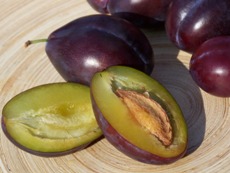 |
They are most often eaten fresh. However, they can also be made into jam, jelly, juice and marmalade. Fruit slices are used in salads and as desert toppings. They can also be dried to make prunes.
Nutrition Facts: Vitamins, Minerals and Phytochemical Components
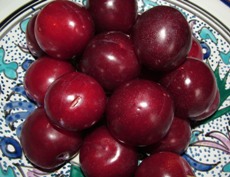 |
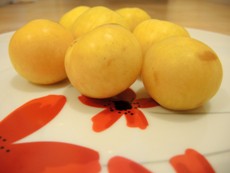 |
They contain high amounts of Vitamin A, C, B2, calcium, potassium, iron, and dietary fiber. It also contain oxalates, which are naturally occurring salts that can crystallize into kidney and gallbladder stones when too much of this compound is consumed. High amounts of oxalates can also inhibit the body’s absorption of calcium.
Health Benefits: Medicinal Uses Based on Scientific Studies
Prunes, which are the dried fruit and prune juice are often used to help regulate the functioning of the digestive system (1). Plums and prunes are known for their laxative effect (1). This effect has been attributed to various compounds present in them, such as dietary fiber, sorbitol, and isatin (1).
Bibliography
- Stacewicz-Sapuntzakis M, Bowen P, Hussain EA, Damayanti-Wood BI, Farnsworth NR. (2001) Chemical composition and potential health effects of prunes: a functional food? Critical Reviews in Food Science and Nutrition, 41(4):251-86.
Disclaimer
Nutritiousfruit.com provides this website as a service. Although the information contained within the website is periodically updated, no guarantee is given that the information provided is correct, complete, and/or up-to-date. The materials contained on this website are provided for general information purposes only and do not constitute legal or other professional advice on any subject matter. Nutrtiousfruit.com does not accept any responsibility for any loss, which may arise from reliance on information contained on this website. The information and references in this website are intended solely for the general information for the reader. The content of this website are not intended to offer personal medical advice, diagnose health problems or to be used for treatment purposes. It is not a substitute for medical care provided by a licensed and qualified health professional. Please consult your health care provider for any advice on medications.
Didn't find what you were looking for? Search here...

Amazon Search Box:
Did you like this page?
|
|
|




